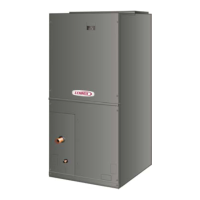Page 22
D-Duct System and Filters
DUCT SYSTEM
The air handler is provided with flanges for the connection
of the supply plenum.
Supply and return duct system must be adequately sized to
meet the system's air requirements and static pressure
capabilities. The duct system should be insulated with a
minimum of 1” thick insulation with a vapor barrier in
conditioned areas or 2” minimum in unconditioned areas.
Supply plenum should be the same size as the flanged
opening provided around the blower outlet and should
extend at least 3 ft. from the air handler before turning or
branching off plenum into duct runs. The plenum forms an
extension of the blower housing and minimizes air
expansion losses from the blower.
INSTALLING DUCT SYSTEM
Connect supply air plenum to the flange on top of the air
handler. If an isolation connector is used, it must be
nonflammable.
A return air duct system is recommended. If the unit is
installed in a confined space or closet, a return connection
must be run, full size, to a location outside the closet.
FIELD-FABRICATED RETURN AIR DUCT FLANGE
FOR HORIZONTAL APPLICATIONS
A return air duct system is recommended, but not
factory-provided. If the unit is installed in a confined space or
closet, run a full-size return connection to a location outside the
closet.
BOTTOM OF
CABINET
DUCT
ADAPTER
1−1/2
(38)
”A”
BRAKE DOWN 90 DEGREES
1/4 (6) DIA.
2−HOLES
”A”
−018 14−7/8 (378)
−024 & −030 18−3/8 (467)
−036 to −060
21−3/4 (552)
1−1/2(38)
3/4
(19)
3/4
(19)
1−1/2
(38)
3/4
(19)
1/2
(13)
3/4
(19)
DUCT
FLANGE
CABINET DOOR
FLANGE
UNIT SIZE
Figure 33. Cabinet and Duct Flange
E-Connecting Refrigerant Lines
Refrigerant lines must be connected by a qualified
technician in accordance with established procedures.
IMPORTANT
Refrigerant lines must be clean, dry, refrigerant-grade
copper lines. Air handler coils should be installed only
with specified line sizes for approved system combina
tions.
Handle the refrigerant lines gently during the installation
process. Sharp bends or kinks in the lines will cause a re
striction.
WARNING
Polyol ester (POE) oils used with HFC-410A refrigerant
absorb moisture very quickly. It is very important that
the refrigerant system be kept closed as much as
possible. DO NOT remove line set caps or service valve
stub caps until you are ready to make connections.
WARNING
Danger of fire. Bleeding the refrigerant
charge from only the high side may result
in the low side shell and suction tubing
being pressurized. Application of a
brazing torch while pressurized may
result in ignition of the refrigerant and oil
mixture - check the high and low
pressures before unbrazing.
WARNING
When using a high pressure gas such as
dry nitrogen to pressurize a refrigeration
or air conditioning system, use a regulator
that can control the pressure down to 1 or
2 psig (6.9 to 13.8 kPa).
CAUTION
Brazing alloys and flux contain materials which are
hazardous to your health.
Avoid breathing vapors or fumes from brazing operations.
Perform operations only in well ventilated areas.
Wear gloves and protective goggles or face shield to
protect against burns.
Wash hands with soap and water after handling brazing
alloys and flux.

